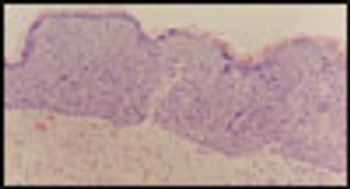
AMSTERDAM -- Testing for the DNA of human papillomavirus -- combined with a Pap smear -- reveals the lesions that lead to cervical cancer earlier than a Pap smear alone, researchers said here.

AMSTERDAM -- Testing for the DNA of human papillomavirus -- combined with a Pap smear -- reveals the lesions that lead to cervical cancer earlier than a Pap smear alone, researchers said here.

CHICAGO -- Immunization with Gardasil, a vaccine designed to prevent infection with human papilloma virus types 6, 11, 16, and 18 may also offer women significant protection against so-called "cousins" of those viral strains, reported researchers here.

ATLANTA -- America's children are getting their shots, but adolescents are lagging, according to the CDC.

HOUSTON -- Human papillomavirus (HPV) infections are likely buoying up oropharyngeal cancer rates while other head and neck cancers decline, researchers said.

VANCOUVER, British Columbia -- Asking patients to collect their own vaginal specimens for HPV testing proved an effective initial screening method among high-risk women, researchers here found.

BRISTOL, England -- For universal vaccination of pre-adolescent girls against human papillomavirus, the development of the vaccine was only the first step to wide-scale cancer prevention.

ROCKVILLE, Md. -- The bivalent vaccine that protects against infection with human papillomavirus does not affect HPV clearance in women with pre-existing infections and should not be considered a treatment modality.

An 82-year-old man is seen for annual physical examination in the nursing home. He has resided there for 1 year because of the aggregate impact of multiple medical problems including, most prominently, laryngeal swallowing dysfunction associated with vocal cord paralysis.

SYDNEY, Australia -- A computerized system for reading liquid-based cytology slides outperformed conventional cytology for detecting cervical abnormalities, investigators here reported.

HELSINKI -- About 90% of early signs of cervical cancer in young women can be prevented by an investigational vaccine against human papillomavirus, according to interim data.

PHILADELPHIA -- The past 12 months have seen new drugs and vaccines for indications from quitting smoking to preventing HPV. Which ones should clinicians embrace and which should they be more cautious about?

HELSINKI, Finland -- The human papillomavirus (HPV) vaccine Gardasil, developed to prevent cervical cancer, also appears to block pre-cancerous vulval and vaginal lesions, researchers said.

LYON, FRANCE -- Smoking and alcohol are independent risk factors for head and neck cancer, but a dose-dependent relationship was observed only for smoking, said researchers here.

SEATTLE -- The quadrivalent human papilloma virus (HPV) vaccine (Gardasil) is nearly 100% effective in preventing disease from two major cancer-causing strains, two industry-sponsored studies reported.

BALTIMORE -- The human papilloma virus -- known to cause a range of anogenital cancers -- is also associated with a dramatically increased risk of some throat cancers, according to researchers here.

BOSTON -- Girls perinatally infected with HIV early in the AIDS epidemic have reached adolescence and a mixed picture is emerging on their reproductive health, researchers here reported.

LOS ANGELES -- Cervarix, an investigational cervical cancer vaccine, prevented all precancerous lesions because of human papillomavirus types 16 and 18 for 5.5 years, researchers reported here.

LOS ANGELES -- Like a Pap smear, detection of abnormal anal cytology is clinically useful in HIV-positive gay men to predict the presence of anal dysplasia, according to researchers here.

ATLANTA -- The Advisory Committee on Immunization Practices of the CDC, as expected, has recommended wide use of the vaccine against four major strains of human papillomavirus that cause cervical cancer.

ATLANTA -- One in four women in the U.S. ages 14 to 59 are infected with human papillomavirus (HPV), according to the first nationally representative study. Some 3.4% of the women tested positive for the four major strains against which the new HPV vaccine protects, representing an estimated 3.1 million women.

A recent editorial in The New York Times heralded the conclusion, from 2 large sub-Saharan African studies, that male circumcision dramatically suppresses HIV acquisition rates as the "most important development in AIDS research since the debut of antiretroviral drugs."1 The editorial went on to state that while a "real [AIDS] vaccine is years away . . . we know its near equivalent [now] exists."1But Anthony Fauci, director of the National Institute for Allergy and Infectious Disease, was more circumspect. "These results could be negated by a small decrease in condom use or the addition of more sexual partners," he cautioned.2

ATLANTA -- A more comprehensive vaccination schedule for children and adolescents has been issued by the CDC for 2007.

BETHESDA, Md. -- Cancer therapy in 2006 was marked, as it is every year, by a string of hits and misses.

A healthy 21-year-old man presented with a rapidly growing, filiform, ringshapedwart on his great toe (Figure).

A 48-year-old African Americanwoman with HIV infection who hadbeen hospitalized several days earlierfor presumed Pneumocystis cariniipneumonia (PCP) is readmittedbecause of worsening dyspnea and atemperature of 38.8oC (102oF).She also complains of painful swellingand erythema on her right arm.Her symptoms have worseneddespite treatment with trimethoprimsulfamethoxazole.